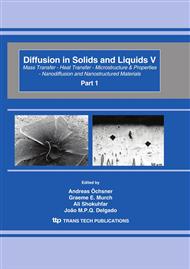p.1190
p.1199
p.1205
p.1210
p.1218
p.1226
p.1232
p.1238
p.1244
The Nature of the Vacancy-Wind Effect Occurring in Diffusion via Six-Jump-Cycles in B2 Intermetallics
Abstract:
First discovered by the late Dr John Manning, the vacancy-wind effect is a subtle phenomenon that occurs when two or more atomic species compete for vacancies in a net vacancy flux. The vacancy-wind effect is incorporated in (for example) the vacancy-wind or Manning factor that appears in the Darken-Manning Equation relating the interdiffusivity, the tracer diffusivities and the thermodynamic factor. The mechanism of the vacancy-wind phenomenon has long been very poorly understood. Recently, a moving reference frame Monte Carlo method was used to illustrate graphically how the vacancy-wind effect operates in both ionic conductivity in an ionic solid with a dilute solute and chemical interdiffusion in concentrated alloys and ionic compounds. That strategy is extended in this paper to show graphically how the vacancy-wind effect operates in interdiffusion in a stoichiometric intermetallic taking the B2 structure. A simple 4-frequency vacancy diffusion model is used. In previous work, it was shown that depending on composition and temperature, this model can exhibit the six-jump-cycle mechanism. It is shown that in the limit of perfect order that there is no vacancy-wind effect associated with this mechanism when both types of cycle operate equally (zero net vacancy flux). The non-unity value of the vacancy-wind factor found for this mechanism under zero vacancy flux conditions is purely a consequence of a particular geometric mix of tracer and collective atom displacements. The concept that a non-zero off-diagonal phenomenological coefficient provides the vacancy-wind effect is verified.
Info:
Periodical:
Pages:
1218-1225
Citation:
Online since:
April 2010
Authors:
Price:
Сopyright:
© 2010 Trans Tech Publications Ltd. All Rights Reserved
Share:
Citation:


